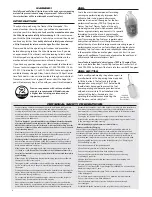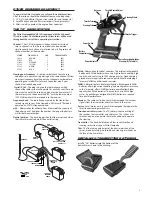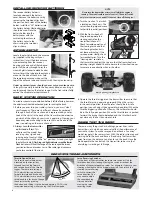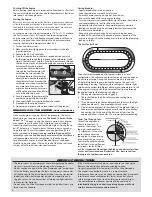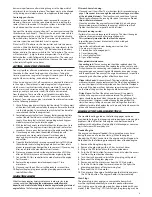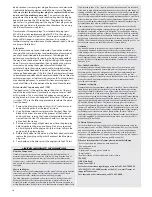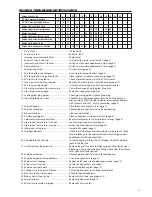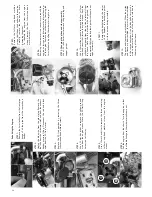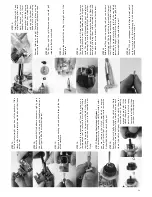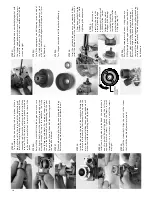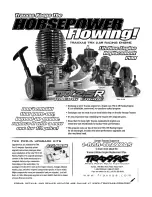
4
RADIO SYSTEM ADJUSTMENTS
Throttle Neutral adjust
The throttle neutral adjustment
is located on the transmitter
face and controls the forward
and reverse travel of the throttle
trigger. There are two settings,
50/50 which allows equal travel
for both forward and brake, and
70/30 which allows more travel for
throttle and less for brake. Change
the adjustment by pressing
the button and sliding it to the desired position. 50/50 is the
recommended setting while running the Nitro Stampede.
Servo Reversing Switches
On the front of the transmitter there are two switches. One for
throttle and one for steering. Moving the switches reverses the
direction of the corresponding servos. For example, if you turn your
steering wheel right and the model moves left, then switch the
steering servo reversing
switch to correct the
servo direction. You
may need to adjust
the corresponding
trim control after
moving the servo-
reversing switch.
TOTAL TRIGGE
R
MOVEMENT
50%
REVERS
E
50%
FORWARD
INSTALLING RECEIVER BATTERIES
The receiver battery holder is
located underneath the battery
cover. Remove the battery cover by
removing the two body clips from
the posts on both sides of the battery
holder. Install four “AA” batteries into
the battery holder. Alkaline batteries
should be used. Place the
battery holder into the
battery cover with the
cushioning foam. Secure
the battery cover to the
chassis using the two body
clips as shown.
ANTENNA SETUP
Locate the plastic tube and the antenna
tip (supplied in the bag with your
instructions). Insert the black antenna
wire, extending from the receiver
housing, into one end of the tube and
push it all the way through. Spray the
wire with glass cleaner to make it easier
to insert Insert the tube into the antenna
mount in the side of the chassis. Fold
the remaining antenna wire over the
top of the antenna tube and secure it with the vinyl antenna tip.
Under no circumstances should you ever cut your antenna wire.
Its length is specially tuned to the frequency band, and cutting it
could severely shorten the radio’s range. On the transmitter,
fully
extend
the chrome telescopic antenna.
RADIO SYSTEM OPERATION
Your radio system was pre-adjusted before it left the factory, however,
the adjustment should be checked prior to running the truck.
1.
Before you ever turn your radio system on, you must “clear”
your frequency. There are six different channels numbered 1
through 6. Each of the six channels is represented by a color.
Look at the crystal in the back of the transmitter to determine
on which of the channels your truck is operating. Clearing your
frequency means checking to be sure that no one else in the
area is operating on the same channel.
2. always turn the transmitter
on first and off last.
This
will prevent the model from
receiving stray signals and
running out of control. Slide
the transmitter switch to the “on” position. A steady red light
should
illuminate.
a flashing red light indicates weak batteries
.
Weak batteries will limit the range of the radio signal between
your transmitter and receiver. Loss of the radio signal can cause
you to lose control of the truck.
3.
Turn the truck on. The switch
is located on the chassis. The
servos should jump and move
to their idle (neutral) positions.
4.
With the front wheels off
the ground, operate the
steering control on the
transmitter (channel 1).
Check for rapid operation of
the steering servo and that
the steering mechanism is
not loose or binding. If the
servo operates slowly, check
for weak batteries. Turn the
“steering trim” control on
the transmitter to adjust the servo so that the front wheels are
pointing straight ahead. Check to be sure that the wheels do not
turn more in one direction than in the other.
5.
Operate the throttle trigger on the transmitter to ensure that
the throttle servo is operating properly. When the servo is
in the neutral position, the carburetor should be in its idle
position (you will adjust the engine idle speed later). When the
throttle trigger is pulled all of the way, the carburetor should
be in the fully-open position. When the throttle lever is pushed
forward, the brake should be locked and the throttle should
not close any further than when at idle.
RANGE TEST THE RADIO
There are many things such as buildings, power lines, radio
transmitters, etc. which can adversely affect the performance of
your radio system. To make sure you do not have a “runaway”
model, range test the radio system. With the radio system on and
working, hold the truck and have a friend carry the transmitter
away from you the distance you plan to run the truck. Have the
friend operate the controls on the transmitter to be sure that
everything is working at full range.
CH.2
CH.1
NOTE:
Never turn the transmitter or receiver off while the engine is
running. The model could run out of control. (The on/off switch
only turns the receiver on and off. It does not turn off the engine.)
FRONT
Wheels pointing straight ahead
CH.2
CH.1


